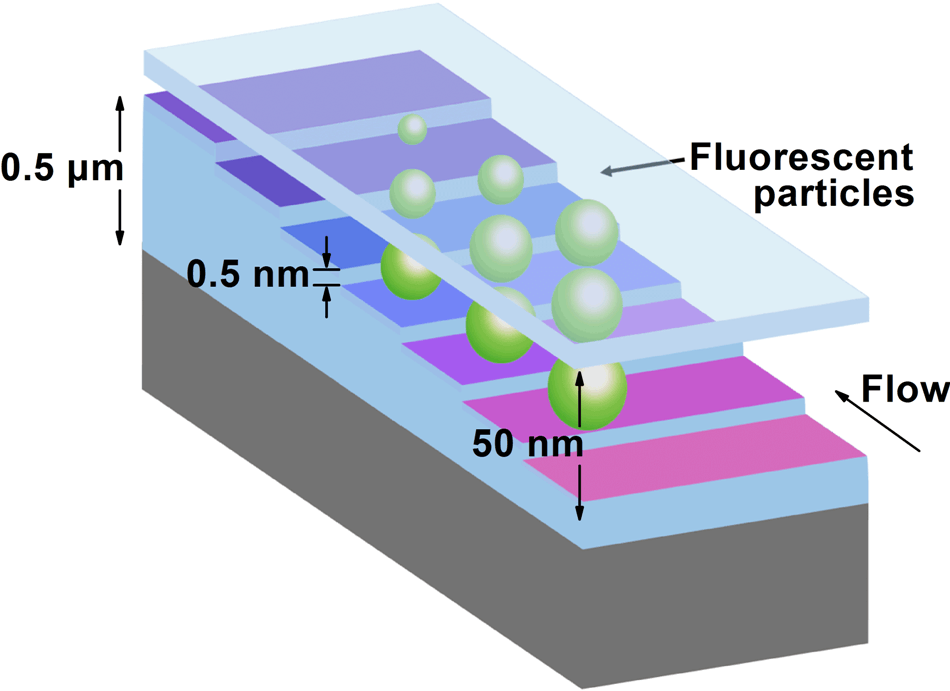Dec 15 2017
Similar to sandblasting at the nanometer scale, focused beams of ions ablate hard materials in order to develop intricate three-dimensional patterns.
The beams are capable of producing small features in the lateral dimensions —width and length, but to develop the next generation of nanometer-scale devices, it is essential for the energetic ions to accurately control the features in the vertical dimension — depth. Researchers at the National Institute of Standards and Technology (NIST) have now proved the possibility of fine tuning a standard ion-beam method in order to make structures with depths controlled to within the diameter of a single silicon atom.
 A nanofluidic staircase machined with subnanometer precision by a focused ion beam separates nanoparticles by size. The device is also a reference material to accurately measure nanoparticle size and compare it to optical brightness, which could aid in the quality control of consumer products. Credit: NIST
A nanofluidic staircase machined with subnanometer precision by a focused ion beam separates nanoparticles by size. The device is also a reference material to accurately measure nanoparticle size and compare it to optical brightness, which could aid in the quality control of consumer products. Credit: NIST
The NIST team, taking advantage of that recently demonstrated precision, used this standard machining technique in order to fabricate devices that permit accurate measurement of the size of nanoparticles in a liquid. The nanofluidic devices, having the potential for mass production, could become a new laboratory standard that will help determine the size of nanoparticles. Such measurements can advance quality control in industrial applications of nanoparticles.
“We have tested and advanced what is possible to make and measure below one nanometer,” said NIST researcher Samuel Stavis. He and his colleagues from NIST and the Maryland NanoCenter at the University of Maryland in College Park reported their findings in a latest edition of Lab on a Chip.
Even though engineers have used ion beams for years in order to fix defects in integrated circuits and machine small parts in mechanical and optical systems, those applications did not need the depth control the team has presently reported.
To realize the overall potential of the process, the team discovered a number of ways for employing a focused beam of gallium ions in order to mill the surfaces of silicon, silicon dioxide, and silicon nitride — materials that are mostly known for the fabrication of nanoscale devices employed in optics, mechanics and electronics. The researchers made use of an atomic force microscope featuring a sensitive probe in order to measure the depth of the topography produced by the ion beam. Careful measurements were vital for testing the restrictions of the ion-beam technique. The facilities at NIST allowed the team to take on both tasks involving precision measurement and precision fabrication.
The team used the new capability to enhance the measurement of the size of nanoparticles. The researchers used a gallium ion beam to machine staircase patterns in silicon dioxide, following which they enclosed them to control the fluid flow at the nanoscale. In a few devices, the researchers machined a staircase with a step size of 1.1 nm; and then they machined others with a step size of 0.6 nm — merely a few atoms in depth.
Fluorescent nanoparticles separate by size in a nanofluidic staircase machined with subnanometer precision.
The steps of the staircase pattern accurately separated nanoparticles that were immersed in water based on their size. Nanoparticles passed in to the deepest step at the bottom of the staircase, but just the smaller ones were able to ascend towards the shallowest step at the top; bigger nanoparticles failed to fit through and continued to be trapped at the bottom set of steps. Fluorescent dye present inside the nanoparticles allowed the team to record their location with an optical microscope, that location was then matched to the known depth of the staircase.
Comparing the nanoparticle sizes specified by this method with the sizes measured using electron microscopy exposed a match that was accurate to within one nanometer. This good agreement of the varied measurements indicates that the devices can serve as a particle separator and also as a reference material in order to measure the sizes of nanoparticles.
Manufacturers who regularly carry out quality control on nanoparticles — determining their average size and also how many of the nanoparticles are slightly larger or smaller than average from batch to batch — could obtain benefits from the new technique. The newly fabricated devices, along with a cost-effective optical microscope to determine the locations of nanoparticles, provide a potentially faster and even more economical route than various other measurement techniques, according to Stavis. The team is presently exploring how the devices could be used as master molds for the mass production of economical replicas.
Since the nanoparticles were measured with the help of an optical microscope, the NIST team was able to study the relationship between the size of nanoparticles and another vital property — their brightness. Clarifying that relationship is essential for studying the properties of such nanoparticles as gold nanoparticles for biomedical sensors, quantum dots for color displays, and other nanoparticles for drug delivery.
The team presented an in depth analysis of their process so that researchers at NIST can immediately take advantage of and adapt the process for their own research. A number of customers from NIST’s nanotechnology user facility, the Center for Nanoscale Science and Technology, where the work was carried out, expressed their interest in employing the technology for measuring both the brightness and size of nanoparticles in these consumer products.
Paper: K-T. Liao, J. Schumacher, H.J. Lezec and S.M. Stavis. Subnanometer structure and function from ion beams through complex fluidics to fluorescent particles. Lab on a Chip. Advance article. Published 29 November 2017. DOI: 10.1039/C7LC01047H (link is external)